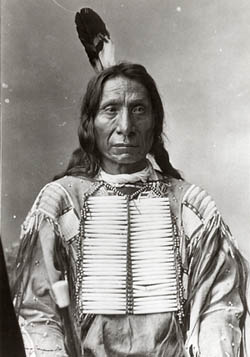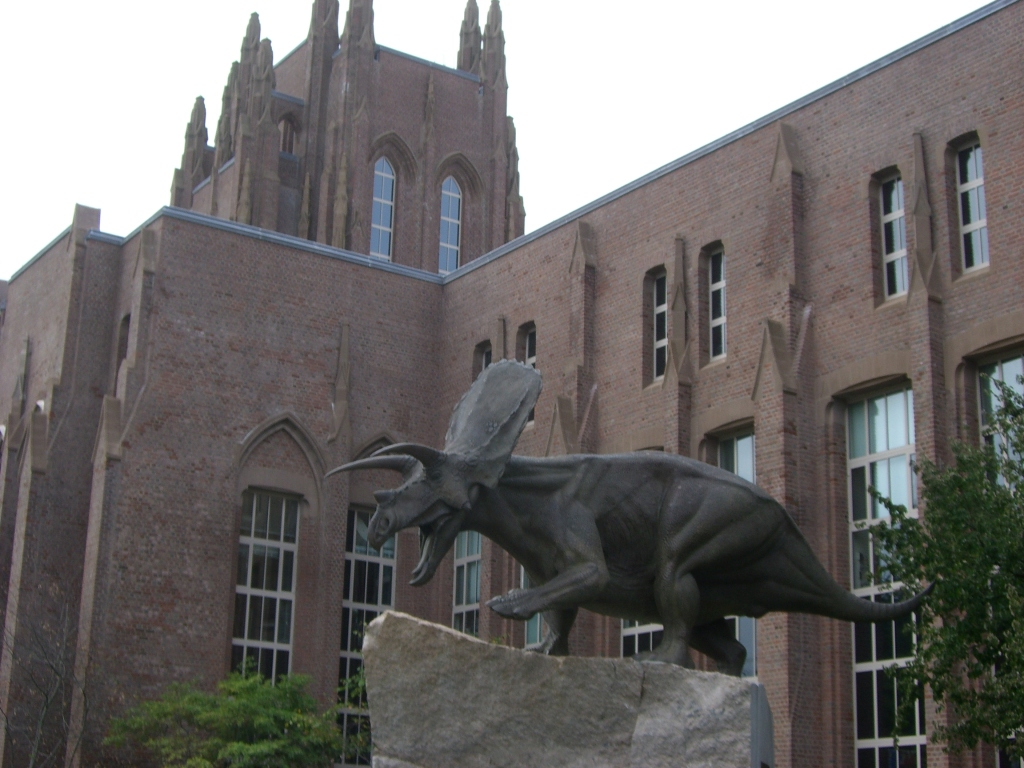The Peabody Museum at Yale
We went down to New Haven a few weekends ago to explore a bit of Yale University, and to check out the train schedules into New York. As an incidental bonus, we also caught sight of the Amtrak “56 Vermonter” train, which is the very train on which the opening scenes of my novel “The Pythagorean Concerto” takes place.
While we were on campus, we visited the Yale Peabody Museum of Natural Sciences. The museum was founded in 1866 by George Peabody, the philantropist uncle of O.C. Marsh, the great paleontologist. Marsh used the museum to house the fossil dinosaur bones he discovered on his excavations in the Western United States in the 1870’s, and from which he mounted his scientific and personal battle with his long-time rival, fellow paleontology Edward Drinker Cope. Their already poor relationship went on a sharp downturn after Cope published a description of Elasmosaurus (a giant aquatic dinosaur) — and Marsh pointed out that Cope had placed the skull on the wrong end of the skeleton. Oops.
 It was on one of his later “Yale College Scientific Expeditions” that Marsh befriended the great chief Red Cloud, head of the Oglala Lakota Sioux. Red Cloud had earlier been at war with the U.S Army and had signed a treaty with the U.S in 1868, but his tribe had the misfortune of residing in gold-rich land, resulting in their forced relocation to the Badlands. Red Cloud only allowed Marsh onto their reservation, in exchange for his promise to communicate the rampant corruption and food problems back to U.S. President Ulysses S. Grant. The chief was pleasantly surprised when Marsh kept his word to Red Cloud, and they remained friends thereafter.
It was on one of his later “Yale College Scientific Expeditions” that Marsh befriended the great chief Red Cloud, head of the Oglala Lakota Sioux. Red Cloud had earlier been at war with the U.S Army and had signed a treaty with the U.S in 1868, but his tribe had the misfortune of residing in gold-rich land, resulting in their forced relocation to the Badlands. Red Cloud only allowed Marsh onto their reservation, in exchange for his promise to communicate the rampant corruption and food problems back to U.S. President Ulysses S. Grant. The chief was pleasantly surprised when Marsh kept his word to Red Cloud, and they remained friends thereafter.
These facts tie in tangentially to my novel. One of the characters, Lilith Cohen-Ptesanwi, is a Jewish-Lakota paleontologist at Hammersmith university, who spent much of her youth out on the Lakota reservations and at many of the digs, and who continues to go out to the Dakotas, Wyoming and Utah each year. This plays a role in a later part of the story.
 We were greeted out front of the museum by a lifesize statue of a Torosaurus, which looks very much like a Triceratops. Inside on the ground floor was a good sampling of the original Marsh collection, including his famous almost-complete Apatosaurus (aka “brontosaurus”). There were also some temporary exhibits, including one called “The Tree of Life”, which was an heroic attempt to explain the current evolutionary theory of life in a way that would appeal to the common sense of evolution-doubters. I’m not sure how well they succeeded in this effort. Some concepts are intrinsically difficult, and require an investment of mental energy that, quite frankly, many people do not (or cannot) bring to the discussion. For those people to whom complex, nuanced chains of thought are simply too much trouble, “God did it” makes a much more satisfying story, and there’s not much you can say in answer to that. You might as well be speaking Swahili.
We were greeted out front of the museum by a lifesize statue of a Torosaurus, which looks very much like a Triceratops. Inside on the ground floor was a good sampling of the original Marsh collection, including his famous almost-complete Apatosaurus (aka “brontosaurus”). There were also some temporary exhibits, including one called “The Tree of Life”, which was an heroic attempt to explain the current evolutionary theory of life in a way that would appeal to the common sense of evolution-doubters. I’m not sure how well they succeeded in this effort. Some concepts are intrinsically difficult, and require an investment of mental energy that, quite frankly, many people do not (or cannot) bring to the discussion. For those people to whom complex, nuanced chains of thought are simply too much trouble, “God did it” makes a much more satisfying story, and there’s not much you can say in answer to that. You might as well be speaking Swahili.
In the “Tree of Life” exhibit, there was a display of live Elephant Shrews, muddling about with their long noses. Contrary to the impression given by this little video, an elephant shrew cannot be identified by its signature call “Momeee! Wook at dat!”
[youtube]4CQKlkEYRfk[/youtube]
After wandering around the first floor for a bit we decided to take a free guided tour by one of the volunteer docents at the museum, a very interesting fellow named Gene Scalise. Gene is a semi-retired finance attorney, who amuses himself by taking on jobs such as grocery clerk, just to find out what that life must be like. We spent almost as much time after the tour just talking the fellow, as we did on the tour itself. He has met a lot of interesting people in his adventures, and is hoping to write a book about it.
